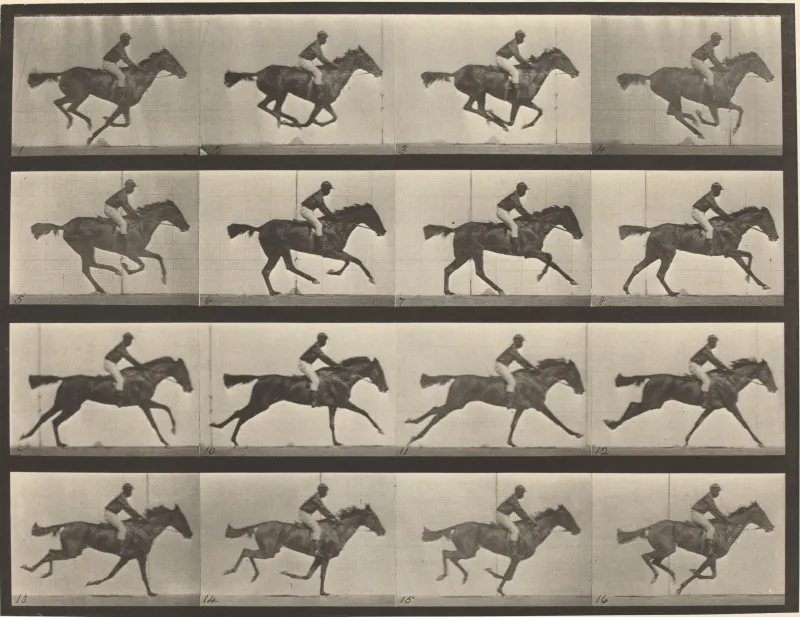Cinema’s roots can be traced back to an obsession with man and machine … and Leland Stanford.
The first recorded moving picture, “The Horse in Motion,” is a sequence of images of a horse galloping. The images were shot with 12 staggered cameras, developed with a wet plate and a bath of silver nitrate and strung together into a film by a notorious technician.
The technician and “father of the motion picture,” Eadweard Muybridge, was a photographer and alleged murderer. “Exposing Muybridge,” a 2021 documentary, unveils how Muybridge’s moving picture originated from a fickle relationship with Leland Stanford.
The film was screened at Menlo Park’s Guild Theater on March 16. Director Marc Shaffer held a panel with Corey Keller, curator of photography at the SFMOMA, and Ryan Coffee, a researcher at SLAC National Accelerator Library, discussing the intersection of art and science.
The documentary sheds light on Muybridge’s perplexing relationship with Leland Stanford, founder of Stanford University. Leland Stanford wanted to win a bet that all four of a horse’s feet come off the ground at a fast trot. Determined to capture a horse in mid-air, he enlisted the help of Eadweard Muybridge in bringing the vision to life.
After Muybridge accomplished this feat, however, Stanford and his friend J.D.B. Stillman used Muybridge’s work in a book but did not credit the photographer. Muybridge subsequently filed a lawsuit against Stanford. The documentary shares that Stanford might have excluded Muybridge out of jealousy of his fame.
The experiments commissioned by Stanford laid the groundwork for Muybridge’s further explorations of human and animal movements. After leaving California, Muybridge created “Animal Locomotion,” a 13-year series of over 30,000 images capturing human motion.
The first scientific study to incorporate photography, the series was as much a scientific innovation as an artistic endeavor. Some of the slides depict silly, strange happenings, such as naked women having tea parties. Muybridge incorporated humor to tell the viewer that the images were in fact manipulated.
In addition, the documentary reveals the artistic process behind Muybridge’s breathtaking photographs of California terrain in his other projects. Muybridge’s film process, which involved opening the shutter for extended periods of time, gave his work an ephemeral quality.
Muybridge’s distinctive style also extends to his use of self portraiture. He used his body as a prop for landscape photography. He became both an extension of nature and a Hitchcockian horror figure; in some shots he performed stunts on cliffs, and in others he eerily stared into the camera.
Despite his artistic accomplishments, the photographer was a controversial character. Enthralled by the idea of celebrity, he mythologized himself by signing his photographs “Helios,” the Greek god of the sun. When being sent to photograph the Modoc War of 1872, a conflict between the U.S. army and the indigenous Modoc people, he staged the combat that he photographed. Most severe of all, he was widely believed to have shot his wife’s lover.
Controversy aside, Muybridge is a point of reference for artists today. His motifs appear in works by Francis Bacon, Sol Lewitt and David Hockney. The most recent artist to nod to the photographer is Jordan Peele, who, like Muybridge, has also been said to “capture the impossible” on film. Peele’s 2022 psychological thriller “Nope” depicts the fictional lives of the grandchildren of the jockey whose horse was filmed in the first ever moving picture.
Many of Muybridge’s contemporaries were doubtful whether his moving pictures were real or fabricated illusions. Leland Stanford claimed that “the machine cannot lie.” But Auguste Rodin, a renowned sculptor, accused Muybridge of lying.
“Exposing Muybridge” shows that “machines cannot say anything.” In fact, it is the humans behind the camera that shape technological growth and push the limits of knowledge. Through marrying science and art in his work, Muybridge urges us to challenge the notion of seeing as believing.
Editor’s Note: This article is a review and includes subjective thoughts, opinions and critiques.
